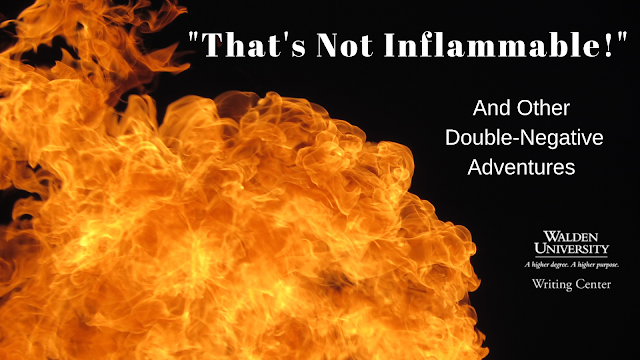"That's Not Inflammable!" and other Double-Negative Adventures
When I was little I tried to use the explanation of double negatives to win arguments.Older kid: “There’s not no such thing as Santa!”
Me: “You said ‘not no’! So you’re saying there is such a thing as Santa!”
This approach did not work. It was probably good foreshadowing for my future career interests, though.
Grammatically speaking, a double negative is when a writer or speaker uses two negations in a single sentence. And a negation is a word or addition to a word that reverses its meaning. Examples of negations include: no, not, nothing, nowhere, never, the prefixes un- (as in, uncovered or unintentional) and in- (as in inexcusable and indirect), and the suffix -less (as in useless and motionless). (Though just because the English language is weird, “flammable” and “inflammable” mean the same thing.)
While it’s sometimes easy to understand the intended meaning of a double negative (like in the case of the kid who argued against Santa’s existence) it’s important to avoid double negatives as they can occasionally be confused with litotes.
Litotes is a fancy word for a figure of speech that uses understatement for emphasis. For example, someone might say “I don’t have no time.” If they are using a double negative, this would mean that they do not have availability in their schedule. In the case of litotes, however, they might be emphasizing the fact that they do have a little time. They could be clarifying that they’re not completely unavailable. Someone who says, “I can’t go nowhere” could either mean they are unable to leave their current location or that they absolutely must leave that location (“I can’t go nowhere!”) Like many other grammar rules, the difference between litotes and double negatives is usually obvious when said aloud, and is clarified by the speaker’s tone. Let's look at a few examples to illustrate my point.
In the 2016 Ghostbusters movie, Kristin Wiig’s character finds herself without her proton energy pack or identifying jumpsuit just as the supernatural apocalypse begins. She rushes to the street to flag down a cab and frantically tells the driver (Dan Aykroyd in a fan-appreciated cameo) where she needs to go. Aykroyd shrugs and tells her, “Eh, that’s a little bit further uptown than I like to go.” When Wiig protests that there are “real ghosts” invading New York, Aykroyd flippantly responds, “I don’t drive wackos, I don’t go to Chinatown, and I ain’t afraid of no ghosts” before driving off. Audiences watching this scene are not likely to confuse Aykroyd's meaning – he doesn’t want to drive Wiig to Chinatown, and he isn’t afraid of the ghosts she points out.
Alternatively, inflection is harder to convey in academic writing. A writer trying to clarify responsibility for patient care, for example, might want to emphasize the patient’s own agency while not diminishing the importance of responsible professional care. Their paper might read, “The patient’s care should not never be considered part of the patient’s own day-to-day priorities.”
Here the writer would want the reader to read this as litotes. But a reader might mistakenly believe the writer is not following conventional grammar rules, and actually believes that the patient’s day-to-day priorities should never include their own care.
To ensure clarity, the writer could revise this to “Although a patient’s care is always an important part of a health professional’s responsibilities, the patient themselves should also prioritize their own care.”
In U.S. academic writing, the onus is on the writer to make sure the reader understands exactly what each sentence means. Since we currently don’t have a way to establish tone and inflection in writing, it’s best to avoid double negatives, even now that you’ve got such an excellent understanding of how they work.
And while this post probably won’t help you win any debates through grammatical explanation, you can impress your friends with your knowledge of “litotes” at your next party. Or you can blow their minds with the whole flammable/inflammable thing.
Kacy Walz is a Minnesota native currently living in St. Louis, MO. She has been a Writing Instructor at Walden since 2016 and spends most of her free time trying to complete her PhD, seeking out adventure, and playing with her puppy dog.
.png)
Never miss a new post; Opt-out at any time
Subscribe to:
Post Comments
(
Atom
)





No comments :
Post a Comment